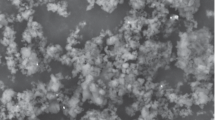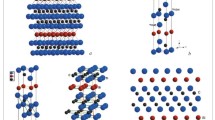Conclusions
As a result of an investigation, into the high-temperature solid-phase reaction of boron carbide with titanium under ordinary and plasma heating conditions, it has been established that the reaction, which begins at 1300°C, is slow in its final stage, which is due to the appearance of a zone of porosity and to disturbed contact between the reactants. Because of this, in spite of its being accompanied by an appreciable thermal effect, the reaction fails to proceed to completion under conditions of both continual ordinary heating (to 1600°C) and plasma heating. It is possible to obtain spray-deposited coatings of the required composition (TiC+TiB2) by employing preconglomerated or clad Ti -B4C powders and preheated basis plates.
Similar content being viewed by others
Literature cited
A. Ya. Artamonov, D. Z. Yurchenko, and N. F. Kirilets, “Facing alloys based on refractory compounds,” in: Refractory Carbides [in Russian], Naukova Dumka, Kiev (1970), pp. 220–222.
V. V. Dzhemelinskii, M. S. Koval'chenko, and G. N. Makarenko, “Indenter materials for high-temperature hardness measurement,” Poroshk. Metall., No. 2, 97–100 (1973).
G. N. Makarenko and É. V. Marek, “Hard materials based on boron carbide,” in: High-Temperature Carbides [in Russian], Naukova Dumka, Kiev (1975), pp. 233–236.
Yu. G. Tkachenko, S. S. Ordan'yan, V. K. Yulyugin, V. I. Unrod, D. Z. Yurchenko, and I. F. Martynova, “Composition dependence of the friction characteristics of Ti and Zr carboboride alloys in a wide temperature range,” Poroshk. Metall., No. 6, 82–87 (1978).
H. Nowotny, C. Benesovsky, C. Brukl. and O. Schob, “Die Dreistoffe: Titan-Bor-Kohlenstoff and Titan-Bor-Stickstoff,” Monatsh. Chem.,92, No. 2, 403–414 (1961).
K. I. Portnoi, G. V. Samsonov, and K. I. Frolova, “Some properties of an alloy of titanium boride and binary titanium-chromium boride with boron carbide,” Zh. Prikl. Khim.,33, No. 3, 577–579 (1960).
S. S. Ordan'yan, V. I. Unrod, and A. I. Avgustinik, “Reactions in the system TiCx-TiB2,” Poroshk. Metall., No. 9, 40–43 (1975).
Yu. S. Borisov, A. L. Borisova, Yu. A. Kocherzhiuskii, and E. A. Shishkin, “Reactions in the TI-Si3N4 system under ordinary and plasma heating conditions,” Poroshk. Metall., No. 3, 63–69 (1978).
G. V. Samsonov and I.M. Vinitskii, Refractory Compound (Handbook) [in Russian], Metallurgiya, Moscow (1976).
Author information
Authors and Affiliations
Additional information
Translated from Poroshkovaya Metallurgiya, No. 9(213), pp. 47—53, September, 1980.
Rights and permissions
About this article
Cite this article
Borisova, A.L., Borisov, Y.S., Shvedova, L.K. et al. Reaction of boron carbide with titanium under ordinary and plasma heating conditions. Powder Metall Met Ceram 19, 621–626 (1980). https://doi.org/10.1007/BF00790553
Received:
Issue Date:
DOI: https://doi.org/10.1007/BF00790553




